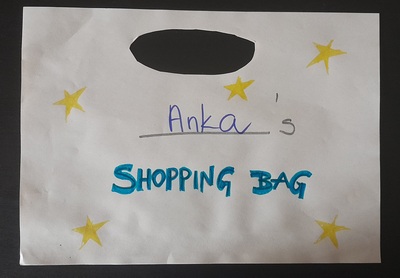
Ingredients
- A lot of paper, in general, in the form of a shopping bag (see photos), cut-outs of food items to be used, one of each per child and a small cardboard rectangle per child for the credit card
- Some furniture for the shop, possibly a poster to put up on the board
- Markers and glue for the group, for colouring and decorating the shopping and the bag
- The video to set the context. I used the cartoon from Playway to English which is available on youtube.

Procedures
- Introduce and practise the vocabulary. I have used it with different groups, ages and topics such as: food, fruit and vegetables, toys, big numbers, with pre-schoolers and primary.
- During the city camp, this was the final part of the day (project), in our regular classes this was usually the last lesson of the unit.
- We started with watching the cartoon and showing the kids our ‘shop’, which is usually just a table with a chair, in front of the board which is also also as the display for all the products available.
- I showed the kids my shopping bag and gave out the templates for them to write their names and decorate it in any way they wanted. The kids glued the sides of their bags together.
- Afterwards, I gave out the small cardboard rectangles and we prepared our credit cards. I cut them up before the lesson and wrote ‘credit card’ on each. We looked at my credit cards and tried to make sure ours include the same information, namely the name and the number.
- Afterwards, all the students were taking turns to come to the shop to do their shopping, to pay, They they went back to their tables to colour the cards. We repeated this stage a few times.
- This time round, I did not include any special preparation as regards the functional language because we were only using the basic forms that we use everyday (Hello, How can I help you, I want / Please, can I have…, That will be, Thank you).
Why we like it
- This was a lovely, communicative lesson. All my students produced a lot of langauge, both as regards the key vocabulary and the functional language. The kids were involved, they kept coming to the shop until they bought absolutely everything.
- The best thing about this activity set up in this way is that despite very moderate resources (only paper, only black and white copies), they kids were fully engage. They took it seriously, they stood in line, they were taking time to make a real decision what to buy. They were also very serious about the payment. I did not want to include any real counting and prices but we did have the moment of the payment being completed, every time the teacher said ‘beep’. And all of it was real despite the fact that our credit cards were made of cardboard and that our terminal was simply my computer mouse. It didn’t matter. The magic did happen with some paper and the careful set up. One of my students commented ‘This is the first time I have gone shopping’. She did not talk about ‘playing shopping’, or ‘pretend play’, she used the verb ‘go shopping’ and she was really serious about it. Looking back, I actually do think that although I had done this activity before, only now, it was especially successful and I believe it was due to the introduction of the credit cards.
- There is a lot of potential for extending the activity, with more complex structures if possible and with elements of maths if we add prices, for older kids. With some groups, I also managed to make it more SS-centred because I was involved only in the first round, for everyone to do their shopping once. In later stages, that is the kids were taking turns. Student A was the shop assistant and student B was the customer. Afterwards, student B would sit down and student A would become the customer, with student C taking over as the shop assistant.
- A lesson of this type can also be used in a variety of lessons: with different topics (clothes, toys, food, furniture), to introduce the idea of money, to teach the kids about the value of coins and notes, although, actually, at this point, the majority of transactions are done via credit cards.
Happy teaching!
1 thought on “Crumbs # 60 Going shopping”